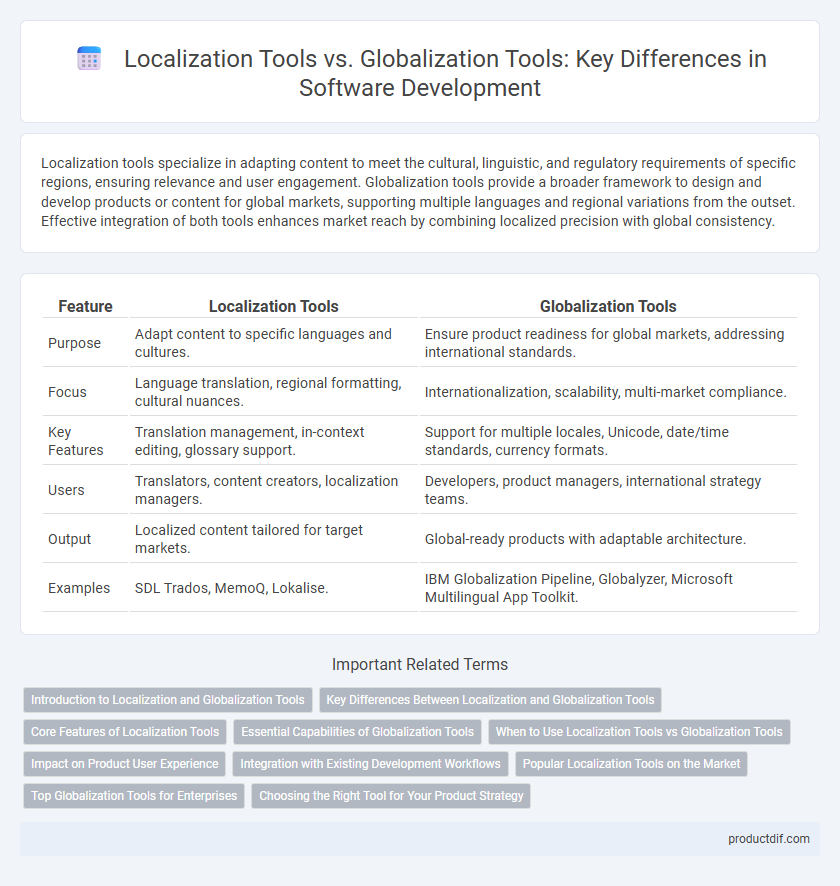Localization tools specialize in adapting content to meet the cultural, linguistic, and regulatory requirements of specific regions, ensuring relevance and user engagement. Globalization tools provide a broader framework to design and develop products or content for global markets, supporting multiple languages and regional variations from the outset. Effective integration of both tools enhances market reach by combining localized precision with global consistency.
Table of Comparison
| Feature | Localization Tools | Globalization Tools |
|---|---|---|
| Purpose | Adapt content to specific languages and cultures. | Ensure product readiness for global markets, addressing international standards. |
| Focus | Language translation, regional formatting, cultural nuances. | Internationalization, scalability, multi-market compliance. |
| Key Features | Translation management, in-context editing, glossary support. | Support for multiple locales, Unicode, date/time standards, currency formats. |
| Users | Translators, content creators, localization managers. | Developers, product managers, international strategy teams. |
| Output | Localized content tailored for target markets. | Global-ready products with adaptable architecture. |
| Examples | SDL Trados, MemoQ, Lokalise. | IBM Globalization Pipeline, Globalyzer, Microsoft Multilingual App Toolkit. |
Introduction to Localization and Globalization Tools
Localization tools adapt software and content to meet the language, cultural, and regional preferences of specific target markets, ensuring user-friendly experiences and compliance with local standards. Globalization tools facilitate the design of products and systems that support multiple languages and regional settings from the outset, enabling seamless scalability and market expansion. Together, these tools streamline the process of entering diverse international markets by addressing linguistic, cultural, and technical challenges efficiently.
Key Differences Between Localization and Globalization Tools
Localization tools specialize in adapting content to meet the linguistic, cultural, and regional preferences of a specific target market, including translation management systems and cultural customization features. Globalization tools provide a comprehensive framework for designing software or content that supports multiple languages and regions from the outset, focusing on internationalization standards and scalable architecture. Key differences lie in localization tools' emphasis on fine-tuning for individual locales versus globalization tools' focus on building versatile, globally compatible solutions.
Core Features of Localization Tools
Localization tools specialize in adapting content to meet the linguistic and cultural requirements of specific regions, offering features such as translation memory, glossaries, and in-context editing. They support file format compatibility, language quality assurance, and version control to ensure accuracy and consistency across localized materials. Integration with content management systems and automation workflows enhance efficiency in managing multilingual projects.
Essential Capabilities of Globalization Tools
Globalization tools provide essential capabilities that extend beyond mere language translation, including cultural adaptation, international market compliance, and seamless integration with global content management systems. These tools support multi-format content localization, automate workflows for consistency across diverse regions, and offer robust analytics to track global engagement. Their advanced features enable businesses to efficiently scale products and services worldwide while maintaining brand integrity and user experience.
When to Use Localization Tools vs Globalization Tools
Localization tools are essential when adapting content to specific regional languages, cultures, and regulations, ensuring a personalized user experience that resonates locally. Globalization tools support the broader strategy by managing internationalization processes, enabling content creation and system design that accommodate multiple languages and markets from the outset. Use localization tools during the final adaptation phase and globalization tools during initial development to streamline expansion into diverse global markets.
Impact on Product User Experience
Localization tools enhance product user experience by adapting interfaces, content, and functionality to specific cultural and linguistic contexts, ensuring higher user satisfaction and engagement. Globalization tools provide a scalable framework for product development, enabling consistent user experiences across multiple markets by supporting multilingual and multicultural adaptations from the design phase. Effective integration of both tools results in a seamless, culturally relevant user experience that drives adoption and loyalty in diverse global markets.
Integration with Existing Development Workflows
Localization tools seamlessly integrate with existing development workflows through APIs, continuous integration support, and version control compatibility. Globalization tools enhance this integration by providing comprehensive frameworks that manage internationalization aspects early in the development cycle. Both tool types optimize software release cycles by automating language adaptations while supporting agile and DevOps practices.
Popular Localization Tools on the Market
Popular localization tools on the market include SDL Trados Studio, MemoQ, and Smartling, which specialize in adapting content for specific languages and regions. These platforms offer features like translation memory, terminology management, and context-specific localization to ensure precise and culturally relevant translations. Unlike globalization tools that handle broader internationalization processes, localization tools focus on linguistic accuracy and regional customization.
Top Globalization Tools for Enterprises
Top globalization tools for enterprises streamline managing multilingual content across diverse markets, enhancing global reach and operational efficiency. These platforms integrate translation management systems, cultural adaptation features, and real-time collaboration to support scalable international expansion. Leading solutions such as SDL Trados Studio, Memsource, and Smartling provide robust APIs and AI-powered translation capabilities tailored for complex enterprise workflows.
Choosing the Right Tool for Your Product Strategy
Choosing the right tool for your product strategy requires understanding the distinct roles of localization tools, which adapt content to specific languages and cultural nuances, versus globalization tools that streamline the management of multilingual content across multiple regions. Localization tools enhance user experience by ensuring cultural relevance and language accuracy, while globalization tools focus on scalable infrastructure and seamless integration for worldwide deployment. Aligning your product goals with these functionalities ensures efficient market entry and maximized global reach.
Localization Tools vs Globalization Tools Infographic

 productdif.com
productdif.com